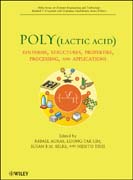
Poly(lactic acid): synthesis, structures, properties, processing, and applications
Auras, Rafael A.
Lim, Loong-Tak
Selke, Susan E.M.
This book describes the synthesis, properties, and processing methods of poly(lactic acid) (PLA), an important family of degradable plastics. As the need for environmentally-friendly packaging materials increases, consumers and companies are in search for new materials that are largely produced from renewable resources, and are recyclable. To that end, an overall theme of the book is the biodegradability, recycling, and sustainability benefits of PLA. The chapters, from a base of international expert contributors, describe specific processing methods, spectroscopy techniques for PLA analysis, and and applications inmedical items, packaging, and environmental use INDICE: List of Contributors. Preface. PART I- CHEMISTRY AND PRODUCTION OFLACTIC ACID, LACTIDE AND POLY(LACTIC ACID). Chapter 1. Production and Purification of Lactic Acid and Lactide. 1.1 Introduction. 1.2 Lactic acid. 1.3 Lactide. References. Chapter 2. Chemistry and Thermodynamic Properties of Lactic acid and Lactide and Solvent Miscibility. 2.1 General properties. 2.2 Thermodynamic properties. 2.3 Miscibility properties of lactic acid and lactide. References. Chapter 3. Industrial Production of High Molecular Weight Poly(lactic acid). 3.1 Introduction. 3.2 Lactic acid based polymers by polycondensation. 3.3 Lactic acid based polymers by chain-extension. 3.4 Lactic acid based polymers by ring-opening polymerization. References. Chapter 4. Design and Synthesis ofDifferent types of poly(lactic acid). 4.1 Introduction. 4.2 Copolymerization.4.3. Properties of copolymers. References. Chapter 5. Structure and Properties of Stereocomplex-type Poly(lactic acid). 5.1 Introduction. 5.2 Formation of stereocomplex crystals. 5.3 Thermal properties of sc-PLA. 5.4 Crystal structure of sc-PLA. 5.5 Formation of sb-PLA. 5.6 Applications of sc-PLA. References. PART II. PROPERTIES OF POLY(LACTIC ACID). Chapter 6. Chemical Structure of Poly(lactic acid). 6.1 Introduction. 6.2 Chain structure and configuration. 6.3 Syndiotactic polymerization and syndiotacticity. 6.4 Conformation. 6.5 Amorphous structure and thermal properties. 6.6 Orientation structure of PLA. 6.7 Semi-crystalline structure. 6.8 Frustrated structure. 6.9 Molecular weight. 6.10 Summary. References. Chapter 7. Chemical Compatibility of Poly(lactic acid) A Practical Framework using Hansen Solubility Parameters. 7.1 A practical framework? 7.2 Solvent compatibility. 7.3 Plasticizers. 7.4 Polymer compatibility. 7.5 Environmental stress cracking. 7.6 Rational composite/nanocomposite design. 7.7 Diffusion s environmental footprint. 26.5 Further Reading on LCA. References. PART V. APPLICATIONS. Chapter 27. Medical Applications. 27.1 Introduction.27.2 Minimal Requirements for Medical Devices. 27.3 Preclinical and Clinical Applications of PLA Devices. 27.4 Conclusions. References. Chapter 28. Packaging and Other Commercial Applications. 28.1 Introduction. 28.2 Applications in Packaging and containers. 28.3 Agricultural and engineering work materials. 28.4 Conclusions. References. Chapter 29. Textile Industry Applications. 29.1Indroduction. 29.2 Manufacturing, Structure and Properties of PLA Fibers. 29.3 Key Performance Features of PLA Fibers. 29.4 Potential Applications. 29.5 Conclusions. References. Chapter 30. Environmental Applications. 30.1 Introduction. 30.2 Application to water and wastewater treatment. 30.3 Application to bioremediation. 30.4 Concluding remarks and perspective. References. INDEX.
- ISBN: 978-0-470-29366-9
- Editorial: John Wiley & Sons
- Encuadernacion: Cartoné
- Páginas: 528
- Fecha Publicación: 15/10/2010
- Nº Volúmenes: 1
- Idioma: Inglés
